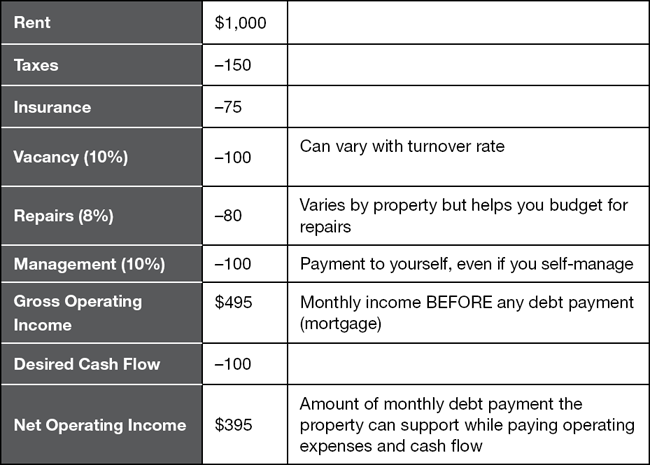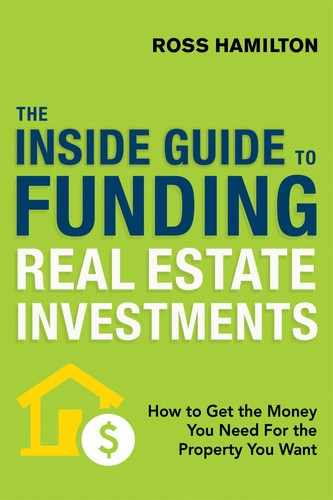WHAT EVERY INVESTOR NEEDS TO KNOW ABOUT TERMS, CASH FLOW, AND FORMULAS
Do You Know What You Don’t Know?
Before you even approach a lender, you have to know the terms of engagement, so to speak. Though you may have purchased a house before, real estate investing is the polar opposite of buying a personal home. Investing is all about the numbers; buying a personal residence is a more emotional undertaking. Sound real estate investment is based on knowing and using tried-and-true formulas and principles.
For real estate investors to succeed, they must know, understand, and use a basic set of formulas to guide their decision making—all based on the numbers.
MAO or the 70 Percent Rule
Used by house flippers, The maximum allowable offer (MAO) formula is based on the 70 percent rule. The 70 percent rule is the notion that an investor cannot pay more than 70 percent of the after-repair value (ARV) of the property after accounting for the cost of your funding, repairs, holding costs, and resale commissions and costs.
The 70 percent rule works as shown in Table 22-1.
Table 22-1. The 70 percent rule for maximum allowable offer (MAO).

If it all plays out as planned, your profit is $32,400 ($108,000 – $75,600), which represents the total expenses minus the purchase price or MAO.
When is it okay to break the 70 percent rule?
•When you have a guaranteed built-in buyer, so there’s no need to pay resale fees.
•When your cost of money is lower (e.g., a subject-to transaction) or you have access to cheap cash
The Wholesaler’s Formulas
Wholesalers use the same basic formula but include a wholesale fee that is determined in one of two ways: a percentage formula or a set-fee formula.
The 65 Percent Rule
They use a 65 percent rule to account for their fee, where:
ARV – Costs to Flip × 0.65 = Max Offer When Wholesaling
Using the example in Table 22-1, the wholesaler would make an offer of $70,200 to the seller and charge the investor-buyer a $5,400 wholesale fee—which is the difference between a 70 percent and 65 percent MAO.
$108,000 × 0.70 = $75,600 (70% Rule)
$108,000 × 0.65 = $70,200 (65% Rule)
$75,600 – $70,200 = $5,400 (Wholesale Fee)
The Set-Fee Formula
Wholesalers also use a set-fee amount. Using the same example as Table 22-1, the wholesaler adds the fee into the costs to flip. Let’s say this wholesaler wanted a bigger fee because it was a difficult property to get under contract. The formula would look something like the one shown in Table 22-2.
Table 22-2. The wholesale set-fee formula

An Alternative to the 70 Percent Rule for Flippers
Every property that is fixed and flipped requires a different amount of time and cash and has different considerations. The 70 percent rule, at its most basic, builds in a 30 percent profit margin and can be a great rule of thumb.
But investors can also look at a property that may be a quick and easy flip and decide that the property is a good deal even if doesn’t meet the 70 percent rule—simply because the time and money needed to complete the deal is less effort.
The Desired Profit Formula
Rather than use a margin, use a set profit amount. For example, let’s say you can pick up a 1,000-square-foot brick ranch in a very marketable neighborhood. The ARV is $150,000. The house only needs some basic cosmetics to bring it up to market, and you can get the job done with little time and hassle. Repair costs are only $12,000, and holding costs are lower because the renovation time is shorter.
In this case, you’ll build in your desired profit (dollar amount) to determine your offer (see Table 22-3).
Table 22-3. The desired profit formula for flipping.

Net Operating Income
Investors looking for cash flow and the benefits of building wealth through more passive rental income use the net operating income (NOI) formula for determining how much financial leverage makes sense.
Rental properties should support themselves. The conservative investor will never over-leverage into a position of negative cash flow. NOI takes into consideration the expenses you have today—although it is important to remember that rents rise over time, as do expenses.
Tables 22-4 and 22-5 show you the basic gross operating income and net operating income formulas to use when considering purchasing or refinancing a rental property. The formulas are based on monthly numbers: rent minus expenses equals cash flow (excluding mortgage payments).
Table 22-4. Gross income for rentals.

The gross operating income tells you how much mortgage the rental property can support today. While some investors own rental properties free and clear, many others don’t. You can use any mortgage calculator to determine how much loan makes sense when funding a rental property when you know the gross rental income.
In this case, the property could support a payment up to $495. So working backward using a mortgage calculator to get to a payment close to $495, you can determine that this property can support a mortgage of around $92,000 for thirty years at 5 percent, for a payment of $493.88.
Gross Operating Income $495 – $493.88 = $1.12 Monthly Cash Flow
It’s important to understand that this example does not result in significant cash flow today. The conservative investor might run the numbers using an NOI formula to include cash flow from day one (see Table 22-5).
Table 22-5. Net operating income for rentals.

With cash flow now built into your numbers, you can use a mortgage calculator to determine how much mortgage the property can support with a loan payment of $395.
There are a multitude of terms, formulas, and strategies that make for sound investing; what I’ve outlined here for you are just a few examples. Commercial investors use capitalization (CAP) rate for multifamily properties. Cash-on-cash calculations help investors compare returns for the use of their available cash. Following these principles and knowing your numbers will keep you from making “feel good” decisions and keep your business strong.
 TAKEAWAYS
TAKEAWAYS
![]() When should you use alternatives to the basic 70 percent rule?
When should you use alternatives to the basic 70 percent rule?
![]() Why does it make sense to use net operating income when determining the financials on a rental property?
Why does it make sense to use net operating income when determining the financials on a rental property?

